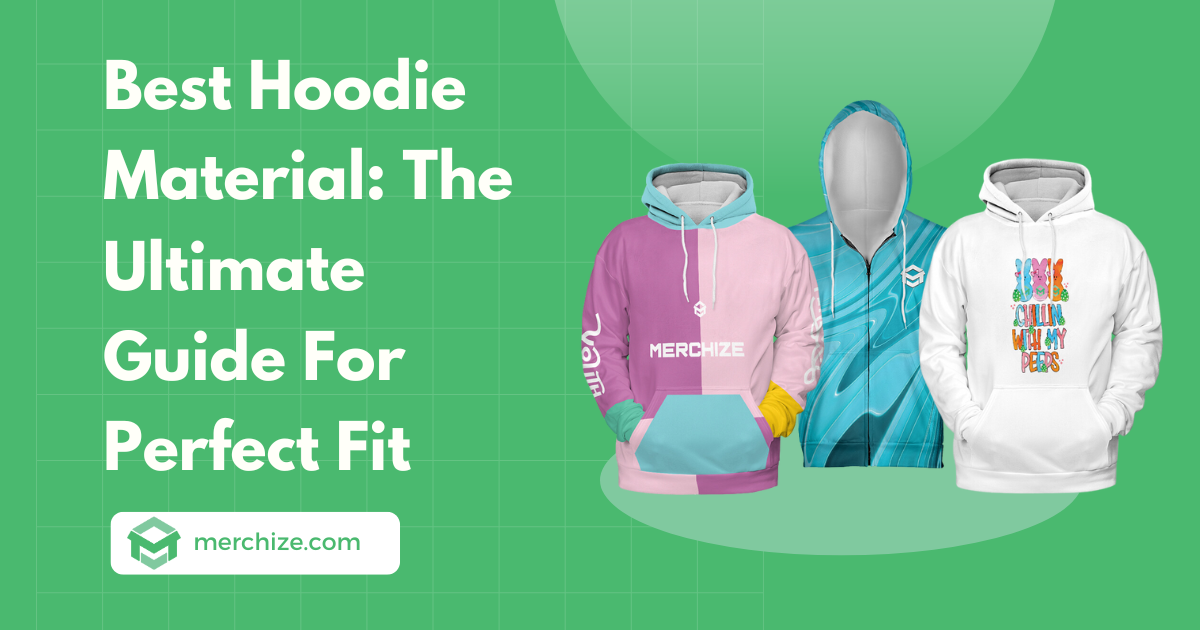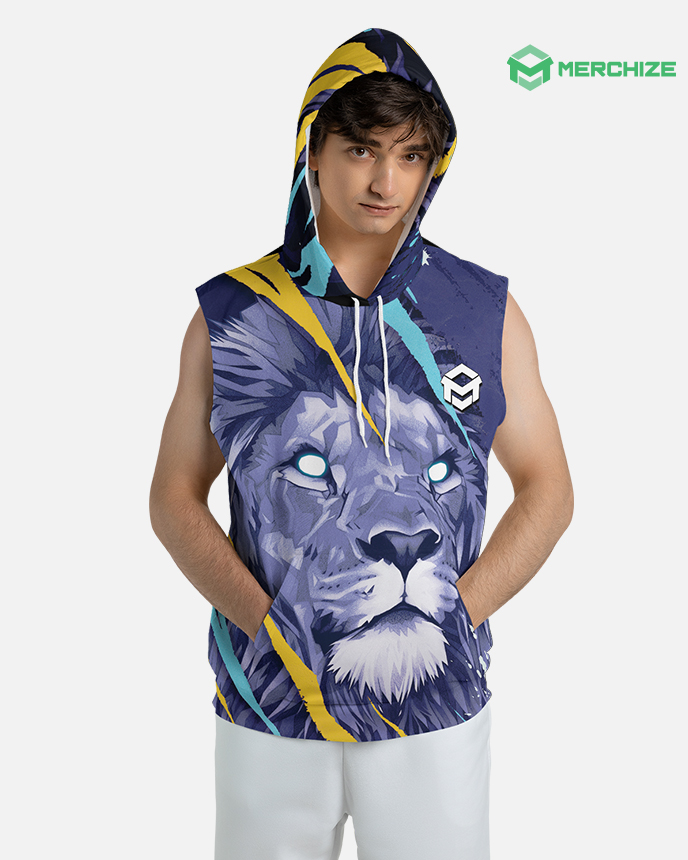Contents
When your own online business sells custom hoodies, good design is not enough. Your hoodies need to be good both in design and material that will make your brand in general and your product in particular memorable. To reach your goals, you need to focus on the material first. That means you must choose the best hoodie material suitable for customers’ needs, brand images, and so on.
In this article, we’ll explore the most outstanding fabric hoodie types and also compare the advantages and disadvantages of each one as well as their specific qualities and customization methods.
Without further ado, let’s dive in!
1. Hoodie fabric weight
When it comes to picking the perfect hoodie material, it’s not only about warmth, softness, or durability. Understanding the subtleties of fabric weight can make a huge difference in selecting just the right piece to meet your customers’ needs. Let’s dig into what fabric weight actually means, why it matters, and how to use it as a guide for different seasons and lifestyles.
- Lightweight from 200 GSM (5.9 OSY) to 250 GSM (7.38 OSY): Lightweight hoodies are crafted for those mild, in-between seasons when it’s just chilly enough for a cozy layer but not quite winter-coat weather. Lightweight cotton blends and polyester fabrics are ideal choices here because they’re breathable and don’t trap excessive heat. Think of these as the “jack-of-all-trades”—light enough for warmer days, versatile enough to be layered when it cools down.
- Mid-weight from 250 GSM (7.38 OSY) to 300 GSM (8.85 OSY): Midweight hoodies strike a balance, offering solid warmth without the bulk. They’re ideal for cooler days, especially in autumn or early spring. A midweight cotton-poly blend gives just the right combination of warmth and breathability, making it suitable for year-round wear depending on your climate. These are fantastic for customers who want a single hoodie to carry them through most of the year, indoors or outdoors, no matter the weather.
- Heavyweight from 350 GSM (8.85 OSY) to 400 GSM (11.8 OSY): Heavyweight hoodies are perfect for those chillier, winter days. These are perfect for layering over thermal shirts or pairing with jackets in colder climates.
- Extra Heavyweight more than 400 GSM (11.8+ OSY): Extra heavyweight hoodies are like wearing a cozy, personal heater. Made from thicker cotton or fleece fabrics, they’re designed to trap heat and shield you from the cold. Heavyweight hoodies offer warmth that’s ideal for those really frosty days when you need that extra layer of protection.
Fabric weight is crucial for determining hoodie suitability across seasons:
- Lightweight for Light Summer Hoodies: Ideal for materials like organic cotton or lightweight blends.
- Midweight for All-Year-Round Hoodies: 7.38 oz/yd² (250 g/m²) to 8.85 oz/yd² (300 g/m²), suitable for cotton-polyester blends or French terry.
- Heavy and extra heavyweight for Cozy Winter Hoodies: 8.85 oz/yd² (300 g/m²) to 11.8 oz/yd² (400 g/m²), perfect for fleece or recycled polyester
2. Hoodie Fabric Composition
Fabric content remains an important factor for customers when choosing clothing. 63% of consumers consider fiber content an important factor in their apparel purchasing decisions. The same goes for hoodies. Here are the 4 main popular fabric content for hoodies:
2.1. 100% Cotton
Cotton is the gold standard for a comfortable, breathable hoodie. It’s naturally breathable, which means it allows air to circulate, keeping the wearer from feeling overly warm or stuffy. But what sets it apart? Cotton is also known for its softness and hypoallergenic properties, making it a solid choice for sensitive skin. Especially with the growing interest in the sustainability of textile materials, cotton is becoming more and more popular.
According to Cotton Incorporated’s Lifestyle Monitor Survey, 73% of U.S. consumers favor fabrics like cotton, denim, and cotton blends. Additionally, 72% of shoppers are willing to pay more for apparel made from natural fibers such as cotton, indicating a strong market demand for natural materials.
A cotton hoodie is ideal for casual wear. Since cotton tends to be durable, it can take a fair amount of wash-and-wear without losing shape. However, it’s worth noting that 100% cotton can shrink slightly after the first wash—something to mention to customers who want a precise fit.
- Soft and comfortable: Cotton is naturally soft and breathable, making for very comfortable wear.
- Natural and hypoallergenic: Great for sensitive skin.
- Good absorbency: Absorbs sweat well, ideal for light activity in warm weather.
- Easy care: Machine washable and generally easy to care for.
- Great for customization: Takes well to dyes and embroidery for colorful or detailed designs.
Printing Tip: Cotton hoodies pair well with DTG (direct-to-garment) printing. The fibers absorb the ink well, which produces bright, lasting prints. If customers are looking for vivid colors and detailed designs, 100% cotton is the way to go.
Best For: Casual wear, loungewear, and summer hoodies. It’s particularly popular for its natural feel and environmental benefits.
2.2. Cotton-polyester blends
If you’re looking for a happy medium between cotton’s softness and polyester’s strength, cotton-polyester blends offer the best of both worlds. The added polyester makes the fabric more durable, helping the hoodie withstand everyday wear and frequent washing without shrinking or fading. These blends often resist wrinkling, so customers don’t have to worry about their hoodie looking like it just came out of a laundry pile. The blend ratio matters, though; let’s take a look at a few types.
- 80/20 Cotton-Polyester Blend: This blend offers a mostly cotton feel but benefits from polyester’s durability. It’s great for customers who want a hoodie that feels soft but doesn’t stretch out easily. Our products use this fabric such as Classic Unisex Hoodie AWDis JH00, Kid Hoodie AWDis JH001J or Classic Unisex Hoodie Comfort Colors 1567. This material is comfortable, breathable, lightweight, yet durable. Moreover, Merchize provides custom hoodie service which is a cool choice for those what-to-wear days for all people. With this print on demand service, you can have creative freedom to make your own hoodie.
- 60/40 Cotton-Polyester Blend: This is an ideal middle ground with balanced comfort and resilience. It’s often used in midweight hoodies that work year-round, perfect for those looking for versatility.
- 50/50 Cotton-Polyester Blend: This blend is durable, easy to care for, and wrinkle-resistant. However, it may lack some of the softness that comes with a higher cotton percentage. Still, it’s a practical choice for activewear hoodies, ideal for everyday, on-the-go customers. At Merchize, we provide several options like Classic Unisex Hoodie Gildan 18500 or Zip Hoodie Gildan 18600. Both of them are super soft, comfortable and also fashionable with metal zip. They also have a good balance between the breathability and comfort of cotton with the wrinkle resistance and durability of polyester.
Here’s how you can choose the best material for your hoodies considering your priorities:
- Softness and breathability: A blend with higher cotton content, like 65/35 cotton-poly or 80/20 cotton-poly, will be softer and more breathable. This is ideal for warmer weather or if you just prefer a comfortable feel.
- Durability and moisture-wicking: A blend with a higher polyester content, like 50/50, or even a tri-blend with polyester like 70/27/3 polyester-cotton-elastane, will be more durable, wrinkle-resistant, and better at wicking away moisture. This is good for activewear or cooler weather.
- Longevity: A blend with more polyester (like 70/30 cotton-poly) will generally last longer. Polyester is more resistant to shrinking, wrinkles, and fading compared to cotton.
- Customization: For vibrant and detailed prints like DTG printing (direct-to-garment printing) or embroidery, a higher cotton content (like 65/35 or 80/20) is preferable. Cotton takes dyes and stitches better, resulting in sharper designs.
Printing Tips: Cotton-poly blends work well with screen printing and embroidery. Polyester provides a strong base for stitching, and the cotton content makes the hoodie comfortable to wear even with embroidery. Just note that DTG printing can sometimes be less vibrant on blends compared to 100% cotton.
Best for: Everyday wear, all-year-round hoodies, and customizable designs. Higher cotton content (e.g., 80/20) is better for warmer weather, while higher polyester content (e.g., 50/50) suits cooler climates.
2.3. Tri-blends
Tri-blends add a third ingredient to the mix, usually cotton, polyester, and rayon. Rayon, a semi-synthetic fiber, brings a unique softness and adds a bit of drape, giving the hoodie a relaxed, vintage feel. It’s perfect for a laid-back day or customers who appreciate a hoodie with character.
Customers looking for something ultra-soft with a light stretch may appreciate tri-blend hoodies. However, keep in mind that tri-blends can be more delicate compared to cotton-poly blends, so they’re best for everyday casual wear rather than heavy-duty use.
Printing Tips: Tri-blends are compatible with sublimation printing if polyester is the dominant fiber and DTG if cotton is the main component. They work best for customers wanting light, faded designs that match the vintage look of the fabric.
Also read: What is a Tri-blend T-shirt?
2.4. 100% polyester
Polyester hoodies are ideal for those who need durability, moisture resistance, and a smooth, modern look. Unlike cotton, polyester is hydrophobic, meaning it repels water instead of absorbing it. This makes polyester hoodies a popular choice for activewear or outdoor use since they wick moisture away from the skin, keeping the wearer comfortable and dry. Polyester also resists wrinkles, stretching, and shrinking, so it’s perfect for those who need a low-maintenance, high-performance fabric.
100% polyester is what customers want to put on for a quick jog to a last-minute outdoor event. It’s designed for customers who don’t want to fuss over their clothes, but still want a polished, ready-for-anything look.
Printing Tip: For customization, sublimation printing is ideal for 100% polyester hoodies. This method uses heat to transfer dye into the fabric, creating vivid, long-lasting designs that don’t fade over time. However, DTG doesn’t always bond as well with polyester, so keep that in mind for complex designs.
Best for: Activewear, winter hoodies, and all-weather versatility.
3. Hoodie Fabric Textures
Hoodie fabrics come in a variety of textures, each offering a different look and feel. Here are they:
Brushed fleece
Brushed fleece is best known for their known for its softness, warmth, and coziness. The fleece is “brushed” to create a soft, slightly fuzzy surface on the inside, which traps warmth and gives that familiar, cushy feel. It’s the go-to fabric for customers who prioritize warmth without sacrificing comfort.
Brushed fleece hoodies are especially popular in cooler climates and winter collections, offering a high warmth-to-weight ratio that keeps customers snug without feeling too bulky.
Brushed fleece is durable enough for everyday wear while remaining soft and comfy. It’s a great choice for casual, all-day comfort and holds up well after multiple washes.
Brushed fleece is a type of fabric known for its softness, warmth, and coziness. It is typically made from cotton, polyester, or a blend of both. The fabric has a napped finish, meaning it has been brushed to create a raised surface of tiny fibers.
This fabric is double-faced: a flat face on one side and a soft, napped face on the other. The soft and smooth napped side faces your body, making it comfortable to wear.
Best for: Casual, everyday hoodies. Whether you’re lounging at home or running errands, brushed fleece is all about comfort. It’s the hoodie you reach for when you want to feel cozy without sacrificing ease.
Sherpa fleece
For customers who crave plush luxury, sherpa fleece delivers. This fabric mimics the fluffy texture of lambswool, making it feel ultra-soft and incredibly warm. Sherpa-lined hoodies often feature this fluffy texture on the inside, making the fabric bulkier but also much warmer. It’s perfect for cold weather and has a high perceived value, making it a great option for winter collections or as a premium product.
Sherpa fleece is designed to keep warmth in, making it less breathable than other fleece but perfect for warmth on cold days.
With our All over Print Fleece Hoodie, your casual will leverage day-to-day style. You can also mix and match with a T-shirt or sweater underneath to make it warmer through the windy and colder days.
Best for: Statement hoodies that double as fashion pieces. Sherpa fleece is perfect for those who want to stay warm while looking effortlessly cool. It’s ideal for outdoor activities in cold weather or as a cozy layer for indoor relaxation.
Minky fleece
Minky fleece, known for its ultra-smooth, velvety finish, brings an added layer of luxury. This plush fabric falls under the category of synthetic fleece, typically made from 100% polyester. Often seen in blankets and soft toys, it’s now popular in loungewear and hoodies designed for ultimate comfort. While it’s not as breathable as other materials, it’s exceptionally soft and has a bit of stretch, which makes it feel indulgent.
All-over Print Fleece Zip Hoodie is also made from minky fleece. This product provides soft and heavy scuba fabric with warm minkly fleece lining inside, which is super comfy and long-lasting.
Best for: Hoodies that blend comfort with style. Minky fleece is perfect for those who want a hoodie that feels as good as it looks. It’s great for casual outings or as a chic, cozy layer at home.
Scuba(95% polyester and 5% spandex)
Scuba fabric made with 95% polyester and 5% spandex is a synthetic knit material commonly used for activewear, dresses, bags, and even some garments. With 95% polyester, this makes the fabric durable, wrinkle-resistant, and relatively fast drying. Polyester fibers are strong and can withstand abrasion, making them suitable for clothing.
By the way, with 5% spandex, this small amount of spandex adds stretch and recovery to the fabric. This allows scuba fabric to hug the body comfortably while still allowing for movement. Scuba’s stretch factor means it holds its shape well, making it resilient for active customers. It doesn’t pill or fade, so it looks fresh even after multiple washes.
Best for: Hoodies that need to look put-together. Scuba is perfect for those who want a hoodie that can transition from casual to slightly more formal settings. Think work-from-home outfits or casual office wear.
Jersey knit fabric
Jersey knit is a versatile fabric that’s smooth and soft with a bit of natural stretch. Typically made of cotton or a cotton blend, it’s breathable and lightweight, making it perfect for transitional seasons or for those who prefer a lighter layer. Jersey knit is also known for its “drape,” so it sits flatteringly on the body without bulk.
Jersey material is made from wool, cotton, or synthetic materials like polyester. This material has 2 types: single-knit jerseys and double-knit jerseys. The former is more lightweight and stretch so it’s suitable for activewear, the latter is less stretchy and more weight. That is the reason why single-knit jerseys are preferred over double-knit jerseys.
Jersey knit is breathable and comfortable, ideal for year-round wear. Customers looking for a relaxed, everyday hoodie that isn’t too warm will love this fabric.
Jersey knit hoodies are for those casual, throw-it-on moments—think running errands or chilling at home. It’s a go-to for customers who want an easy, no-fuss hoodie that looks good with everything.
Best for: Layering or warmer weather hoodies. Jersey knit is perfect for active individuals who need a hoodie that allows for movement. It’s ideal for workouts, casual everyday wear, or as a light layer on breezy days.
Corduroy
Corduroy is a type of woven fabric where the weft threads are cut to create the raised corduroy wales. Corduroy, with its ribbed, textured finish, adds a retro touch to the hoodie lineup. Known for its durability and distinct texture, corduroy is a heavier fabric, making it ideal for cooler months. While it’s not as flexible or soft as other materials, corduroy hoodies are eye-catching and unique.
Corduroy is highly durable but less stretchy. Customers looking for a trendy, statement piece will love its vintage vibe. This material is usually to make coats, slacks, jackets, and also hoodies.
Best for: Stylish, distinctive hoodies. Corduroy is perfect for those who want a hoodie that stands out and adds a touch of retro flair. It’s great for casual outings or as a statement piece that sparks conversation.
Wool
Wool hoodies bring the natural warmth and moisture-wicking properties of wool into a more casual piece. Wool is perfect for the coldest months, offering superior warmth while naturally repelling odors. Wool hoodies have a high-end feel but require special care, so they’re perfect for customers who prioritize warmth and are willing to invest in a premium fabric.
Hoodies made from wool are great but the price is more expensive to produce than other fabrics like cotton and polyester. Moreover, the products from wool have more shrinkage so you need to hand-wash them to protect the best. So, if you’re looking for a comfortable, warm, and eco-friendly fabric option, wool is definitely worth considering.
Wool is incredibly warm yet breathable, making it an excellent insulator. It’s ideal for winter wear and offers moisture-wicking properties that keep the wearer dry.
Best for: Cold weather and outdoor adventure hoodies. Wool is perfect for those who need a hoodie that can withstand harsh conditions while keeping them toasty. It’s ideal for hiking, camping, or any time you’re braving the elements.
Factors you need to consider when choosing the best hoodies material
Before deciding what is the best hoodie material, you need to know several factors below:
Warmth
How warm do you want your hoodie to be? This might seem obvious, but not all hoodies are made for the same weather.
If you’re after a warm, snuggly feel, go for thicker fabrics like fleece or wool blends. These trap body heat effectively, making them great for colder days. Think about a heavy cotton hoodie lined with fleece—it’s like being wrapped in a cozy blanket.
For something more lightweight, cotton blends with polyester can give that just-right warmth without feeling too heavy.
Durability
Let’s face it; hoodies are everyday essentials. You wear them to the gym, on hikes, and even to bed sometimes. So, durability is key. Look for fabrics that can stand up to repeated wear and washes without losing shape or softness. Cotton blends or polyester-based materials are champs here—they’re tough, hold up well over time, and often resist shrinking.
Comfort
A hoodie should be like your second skin. If it’s scratchy, itchy, or stiff, it’s just not going to cut it. Cotton is the go-to for softness, while blends add a bit of stretch, making them perfect for all-day wear.
Think of those ultra-soft hoodies that almost feel like a warm hug every time you put them on. If comfort’s a top priority, try 100% cotton for that plush, all-day feeling, or a cotton-spandex mix if you like a bit of give for extra coziness.
Styles and personal preferences
This is where it gets fun—your style plays a big role in choosing material. For a vintage look, you might prefer cotton, as it gives that naturally worn-in vibe. Want something a little sleeker and sportier? Polyester or spandex blends often bring a more lightweight and breathable quality, perfect for that post-workout chill.
- Casual wear hoodies: It prioritizes comfort and aesthetics. Soft fleece or jersey knit fabrics with a relaxed fit are great for lounging or everyday wear. You need to look for materials like cotton or cotton blends for breathability or choose wool for added warmth.
- Activewear hoodies: This hoodie style focuses on functionality. Breathable fabrics like moisture-wicking polyester blends or lightweight jerseys will help regulate your body temperature during exercise. Let’s opt for materials with stretch, like those with spandex content, to allow for freedom of movement.
Sum up
| Hoodie Material | Softness | Breathability | Durability | Customization Compatibility | Pros | Cons |
| Brushed Fleece | Very soft | Moderate | High | Great for DTG and screen printing | Warm, cozy, holds up well over time | Not ideal for summer or warm climates |
| Sherpa Fleece | Ultra-soft | Low | Moderate | Suitable for embroidery | Luxuriously plush, warm for cold weather | Can be bulky; not breathable |
| Minky Fleece | Ultra-soft | Low | Moderate | Best for embroidery | Velvety feel, feels luxurious | Limited breathability, not ideal for DTG |
| Scuba Fabric | Smooth and slightly stretchy | Low | High | Works best with embroidery | Sleek, durable, and stylish | Not ideal for DTG, can be less breathable |
| Jersey Knit Fabric | Soft | High | Moderate | Great for screen printing and embroidery | Lightweight, breathable, good for layering | Not as durable for intricate DTG designs |
| Corduroy | Firm texture | Low | High | Suitable for embroidery | Vintage style, highly durable | Not stretchy, not suitable for DTG |
| Wool | Moderate | Moderate | High | Limited customization; embroidery possible | Excellent warmth, natural moisture-wicking | Requires special care, can feel coarse |
| 100% Cotton | Very soft | High | Moderate | Ideal for DTG, screen printing | Breathable, natural feel, holds print well | Shrinks if not pre-shrunk, less durable |
| Cotton-Poly Blend | Soft | Moderate | High | Great for DTG, screen printing, embroidery | Durable, retains color well | Less breathable than 100% cotton |
| Tri-Blend | Very soft | High | High | Excellent for DTG, screen printing | Super-soft, resistant to shrinking | Typically more expensive |
| 100% Polyester | Smooth | Low | High | Works best with sublimation, embroidery | Durable, moisture-wicking | Not as breathable as cotton blends |
Recommendations for Specific Use Cases:
- Summer Hoodies: Opt for lightweight organic cotton or 80/20 cotton-polyester blends for breathability.
- Winter Hoodies: Choose heavyweight fleece, recycled polyester, or merino wool blends for warmth and insulation.
- Activewear: Select moisture-wicking recycled polyester or polyester blends with elastane for stretch and durability.
- Everyday Wear: All-season blends like 50/50 or 65/35 cotton polyester offer versatility and comfort.
- Sustainable Options: Prioritize organic cotton, recycled polyester, or organic French terry for eco-conscious choices.
We hope that you can have detailed information about each material’s characteristics to choose what is the best material for hoodies for printing your designs. By the way, let’s remember to check the fabric weight and then consider which one is the best for each occasion.
After it’s done, feel free to start the manufacturing process. While proceeding, you also check carefully what printing method and how materials affect print quality, durability, and so on. To check and know that it has a good or bad review when the customer receives it, let’s order a product sample to see how it looks in real life.
And if you’re looking to design your own custom hoodie using a POD (Print-on-Demand) service, let’s sign up today with Merchize, your trusted POD fulfillment partner, and start your journey to success!






